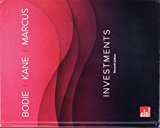
a.
To compute: The value by which a contract is mispriced with the help of given information.
Introduction:
Future contract: It is supposed to be a legal agreement required to purchase or sell a commodity or asset in the future. This contract will specify the price at which the purchase or sale of the commodity or asset should be done at a specified time which will be agreed by the parties in advance.
b.
To prepare: A zero-net-investment arbitrage portfolio to show that riskless profits can be equalized to futures mispricing.
Introduction:
Zero-net investment arbitrage strategy: According to this startegy, the securities should be purchased or sold in such a manner that the net result i.e., net investment becomes zero.
c.
To evaluate: The existence of arbitrage opportunity assuming the short sales of the stock in market index and the income is not received.
Introduction:
Arbitrage opportunity: It is an opportunity which can be availed to make a risk-free profit even in market fluctuations. The process of arbitrage involves buying of an asset in one market with a lesser price and sell it another market with a higher price.
d.
To compute: The no-arbitrage band for the stock-futures price relationship. Given stock index of 1900.
Introduction:
No-arbitrage: No-arbitrage can also be called as arbitrage- free principle. According to this principle, the price of the derivative is fixed in such a way that no one involved in trading can make a risk-free profit by purchasing one and selling the other.
Want to see the full answer?
Check out a sample textbook solution
Chapter 23 Solutions
Investments, 11th Edition (exclude Access Card)
- Which of the following best defines the term "capital structure"?A) The way a company raises its capital through debt and equityB) The investment decisions made by a companyC) The amount of profit a company generatesD) The distribution of earnings to shareholdershelparrow_forwardWhich of the following best defines the term "capital structure"?A) The way a company raises its capital through debt and equityB) The investment decisions made by a companyC) The amount of profit a company generatesD) The distribution of earnings to shareholdersarrow_forwardThe time value of money concept is based on the idea that: A) Money loses value over timeB) Money has the same value over timeC) The value of money increases over time due to inflationD) A dollar today is worth more than a dollar in the futurehelparrow_forward
- The time value of money concept is based on the idea that: A) Money loses value over timeB) Money has the same value over timeC) The value of money increases over time due to inflationD) A dollar today is worth more than a dollar in the future explain.arrow_forwardThe time value of money concept is based on the idea that: A) Money loses value over timeB) Money has the same value over timeC) The value of money increases over time due to inflationD) A dollar today is worth more than a dollar in the futurearrow_forwardWhich of the following is the most appropriate metric for determining a company's profitability?A) Return on Assets (ROA)B) Debt-to-Equity RatioC) Price-to-Earnings (P/E) RatioD) Current Ratio need helparrow_forward
- Which of the following is the most appropriate metric for determining a company's profitability?A) Return on Assets (ROA)B) Debt-to-Equity RatioC) Price-to-Earnings (P/E) RatioD) Current Ratio explain.arrow_forwardWhich of the following is the most appropriate metric for determining a company's profitability?A) Return on Assets (ROA)B) Debt-to-Equity RatioC) Price-to-Earnings (P/E) RatioD) Current Ratioarrow_forwardWhat does the term "liquidity" refer to in financial management?A) The profitability of a companyB) The ease with which an asset can be converted into cashC) The long-term sustainability of a companyD) The company's capital structure helparrow_forward
- What does the term "liquidity" refer to in financial management?A) The profitability of a companyB) The ease with which an asset can be converted into cashC) The long-term sustainability of a companyD) The company's capital structurearrow_forwardWhich of the following is a method for valuing a stock using expected future dividends?A) Net Present Value (NPV)B) Dividend Discount Model (DDM)C) Price-to-Earnings (P/E) RatioD) Internal Rate of Return (IRR) explain.arrow_forwardWhich of the following is a method for valuing a stock using expected future dividends?A) Net Present Value (NPV)B) Dividend Discount Model (DDM)C) Price-to-Earnings (P/E) RatioD) Internal Rate of Return (IRR)arrow_forward
 EBK CONTEMPORARY FINANCIAL MANAGEMENTFinanceISBN:9781337514835Author:MOYERPublisher:CENGAGE LEARNING - CONSIGNMENT
EBK CONTEMPORARY FINANCIAL MANAGEMENTFinanceISBN:9781337514835Author:MOYERPublisher:CENGAGE LEARNING - CONSIGNMENT
